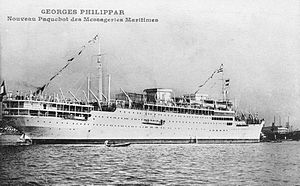MS Georges Philippar
 |
|
| History | |
|---|---|
|
|
|
| Name: | Georges Philippar |
| Namesake: | Georges Philippar |
| Owner: | Cie des Messageries Maritimes |
| Port of registry: | Marseilles |
| Builder: | Soc des Ateliers et Chantiers de la Loire, St Nazaire |
| Launched: | 6 November 1930 |
| Completed: | January 1932 |
| Out of service: | 15 May 1932 |
| Identification: |
|
| Fate: | Sank |
| General characteristics | |
| Tonnage: | |
| Length: | 542.7 ft (165.4 m) |
| Beam: | 68.2 ft (20.8 m) |
| Depth: | 46.9 ft (14.3 m) |
| Installed power: | 3,300 NHP |
| Propulsion: | 2× 10-cylinder 2S SC SA marine diesel engines; twin screws |
| Speed: | 18 1⁄2 knots (34.3 km/h) |
| Crew: | 347 |
Georges Philippar was an ocean liner of the French Messageries Maritimes line that was built in 1930. On her maiden voyage in 1932 she caught fire and sank in the Gulf of Aden with the loss of 54 lives.
Georges Philippar was a 17,359 GRT ocean liner. She was 542.7 ft (165.4 m) long, with a beam of 68.2 ft (20.8 m) and a depth of 46.9 ft (14.3 m). She was a motor ship with two two-stroke, single cycle single-acting marine diesel engines. Each engine had 10 cylinders of 28 3⁄4 inches (730 mm) bore by 17 1⁄4 inches (440 mm) stroke and was built by Sulzer Brothers, Winterthur, Switzerland. Between them the two engines developed 3,300 NHP, giving the ship a speed of 18 1⁄2 knots (34.3 km/h).
Georges Philippar was built by Ateliers et Chantiers de la Loire, Saint-Nazaire for Compagnie des Messageries Maritimes to replace Paul Lacat, which had been destroyed by fire in December 1928. She was launched on 6 November 1930. On 1 December 1930 she caught fire while being fitted out. Named after French Mesageries Maritimes CEO Georges Philippar, she was completed in January 1932. She was registered in Marseilles.
Before she started her maiden voyage, French police warned her owners that threats had been made on 26 February 1932 to destroy the ship. The outward voyage took Georges Philippar to Yokohama, Japan, without incident and she started her homeward voyage, calling at Shanghai, China and Colombo, Ceylon. Georges Philippar left Columbo with 347 crew and 518 passengers aboard. On two occasions a fire alarm went off in a store room where bullion was being stored, but no fire was found. The Georges Philippar class was an innovative design, experimenting with Diesel propulsion, sporting unusual square section short smokestacks (whimsically dubbed flower pots by the sailors) and an extensive use of electricity, for lighting, kitchen and deck winches. Georges Philippar, the CEO of Messageries Maritimes and ship namesake created a special Greek-Latin term "Nautonaphtes" (Oil-powered ships) for advertising purposes as he felt that Diesel sounded too Germanic for post WW1 French public.
...
Wikipedia
